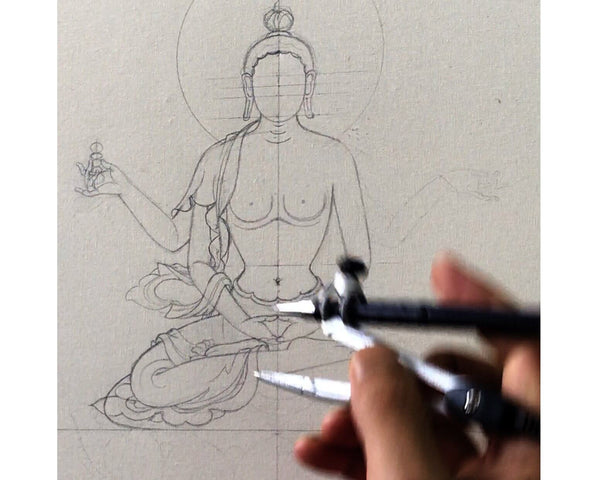Sangye: The Resonant Tibetan Name for the Enlightened One
The word "Sangye" holds a special place in the hearts and minds of Tibetans, as it represents one of the most revered figures in their spiritual world. Sangye is the Tibetan term for Buddha, symbolizing enlightenment and the ultimate attainment of wisdom. While Buddha is a universal term, understanding its significance in Tibetan culture is essential for those interested in Tibetan Buddhism.
"Clear, luminous mind itself
Is the essence of the three mandalas
Having understood this, pay single-minded attention,
And the supreme fruition will be attained."
Sangye refers to the one who has to awaken (sang) from the deep sleep of ignorance and whose mind has blossomed (gye) like a lotus flower to the knowledge of all things. Through one's remaining nondual awareness, enlightenment is revealed, although, in reality, there is nothing to adopt and nothing to purify in the true nature of the mind. As Accomplished of Wisdom says:
Key Takeaways:
- Sangye is the Tibetan term for Buddha.
- The word is emblematic of the journey to enlightenment.
- Tibetan Buddhism has unique characteristics different from other forms of Buddhism.
- Sangye provides insight into Tibetan culture, beliefs, and spiritual practices.
Understanding the Etymology: Sangye
Sangye can be divided into two parts:
- Sang: This refers to the 'awakening' or 'clearing away' of delusions and the obstructions that hinder our spiritual progress.
- Gye: This denotes the 'expansion' or 'development' of good qualities, such as wisdom and compassion.
Together, these two terms signify the full realization of a Buddha – one who has eliminated all negativities and perfected all virtues.
A Buddha is a fully awakened, fully evolved being and a perfect teacher of enlightenment to humans and gods. Shakyamuni Buddha's ideal wisdom experiences the exact nature of reality, whereas their perfect compassion embodies the will to others' happiness. A Buddha is both human and divine. He is the adamantine embodiment of the ultimate freedom that is omnipresent as all forms of love and goodness within this relative reality.
While the term "Buddha" is used globally across different forms of Buddhism, the Tibetan term Sangye has a distinct significance. It captures the essence of Tibetan beliefs about the journey to enlightenment and the ultimate goal of spiritual practice.
The Historical Shakyamuni Buddha
Click here to view our Buddha Crystal Statue
A Buddha is not a Creator. Evil comprises the bad habits of oneself and others, rooted in a misconception of reality and misunderstanding of the self as the absolute, self-sufficient, and ultimately estranged entity. Such conceptions only lead us towards greed and hate.
They ultimately cause evolutionary misdeeds, such as stealing and killing, which are the natural causes of suffering. Evil is merely suffering, and sound is happiness. The purpose of life is to get rid of all suffering and find absolute pleasure.
The Bodhisattvas also help us attain this, as they are Buddhas who remained in the realm of the mortals and delayed their elevation to higher consciousness so that the sentient beings could benefit from it.
A Buddha has three bodies - the body of Truth, Beatitude, and Emanation. Among the three bodies, the truth body (Dharmakaya) is reality worn as a body that shows absolute fulfillment. The heavenly body (Sambhogkaya) is the bliss that results from fulfillment.
The emanation body (Nirmanakaya) emerges from that union of wisdom and bliss and leads the suffering beings into a field of happiness. The emanation body is the living Buddha art, inspired by the Buddha' loving will to lift beings out of their mundaneness and help them in their spiritual fulfillment.
The Role of Sangye in Tibetan Spiritual Practices
- Mantras and Chants
In Tibetan Buddhism, mantras play an essential role in meditative practices. The Sangye mantra, commonly recited, helps practitioners focus their minds and invoke the blessings of the Buddha. By repeatedly chanting this mantra, practitioners aim to cleanse their minds and bring themselves closer to enlightenment.
- Thangka Paintings

- Click here to our Hand-Painted Buddha Thangka
Thangka paintings are traditional Tibetan artworks that depict various deities, saints, and spiritual symbols. Many of these paintings showcase Sangye or Buddha, symbolizing his revered status in Tibetan culture. These artworks serve both as a devotional tool and a medium to impart spiritual teachings.
Distinguishing Tibetan Buddhism
Tibetan Buddhism, while sharing many foundational beliefs with other forms of Buddhism, has its unique characteristics:
- Esoteric Teachings: Tibetan Buddhism emphasizes esoteric teachings and practices, not in other traditions.
- Role of the Lama: The spiritual teacher, or Lama, holds a central place in Tibetan Buddhism. They guide disciples on their spiritual journey and are considered embodiments of Sangye or Buddha.
|
Buddhism Type |
Key Characteristics |
|
Theravada |
Oldest form, focuses on individual enlightenment |
|
Mahayana |
Emphasizes compassion and the Bodhisattva path |
|
Tibetan |
Esoteric teachings, role of the Lama |
Tibetan Buddhism and the concept of Sangye deeply influence Tibetan culture. From traditional arts to daily rituals, the teachings of the Buddha permeate every aspect of life, making it a spiritual and cultural cornerstone.
Understanding Sangye provides a deep insight into Tibetan culture, beliefs, and spiritual practices. The term, representing the journey to enlightenment, embodies the aspirations and goals of every Tibetan Buddhist practitioner. By embracing the wisdom of Sangye, one steps closer to the path of self-realization and inner peace.


